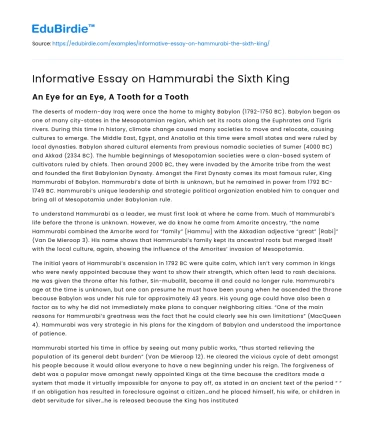An Eye for an Eye, A Tooth for a Tooth
The deserts of modern-day Iraq were once the home to mighty Babylon (1792-1750 BC). Babylon began as one of many city-states in the Mesopotamian region, which set its roots along the Euphrates and Tigris rivers. During this time in history, climate change caused many societies to move and relocate, causing cultures to emerge. The Middle East, Egypt, and Anatolia at this time were small states and were ruled by local dynasties. Babylon shared cultural elements from previous nomadic societies of Sumer (4000 BC) and Akkad (2334 BC). The humble beginnings of Mesopotamian societies were a clan-based system of cultivators ruled by chiefs. Then around 2000 BC, they were invaded by the Amorite tribe from the west and founded the first Babylonian Dynasty. Amongst the First Dynasty comes its most famous ruler, King Hammurabi of Babylon. Hammurabi’s date of birth is unknown, but he remained in power from 1792 BC-1749 BC. Hammurabi’s unique leadership and strategic political organization enabled him to conquer and bring all of Mesopotamia under Babylonian rule.
To understand Hammurabi as a leader, we must first look at where he came from. Much of Hammurabi’s life before the throne is unknown. However, we do know he came from Amorite ancestry, “the name Hammurabi combined the Amorite word for “family” [Hammu] with the Akkadian adjective “great” [Rabi]” (Van De Mieroop 3). His name shows that Hammurabi’s family kept its ancestral roots but merged itself with the local culture, again, showing the influence of the Amorites’ invasion of Mesopotamia.
Save your time!
We can take care of your essay
- Proper editing and formatting
- Free revision, title page, and bibliography
- Flexible prices and money-back guarantee
The initial years of Hammurabi’s ascension in 1792 BC were quite calm, which isn’t very common in kings who were newly appointed because they want to show their strength, which often lead to rash decisions. He was given the throne after his father, Sin-muballit, became ill and could no longer rule. Hammurabi’s age at the time is unknown, but one can presume he must have been young when he ascended the throne because Babylon was under his rule for approximately 43 years. His young age could have also been a factor as to why he did not immediately make plans to conquer neighboring cities. “One of the main reasons for Hammurabi’s greatness was the fact that he could clearly see his own limitations” (MacQueen 4). Hammurabi was very strategic in his plans for the Kingdom of Babylon and understood the importance of patience.
Hammurabi started his time in office by seeing out many public works, “thus started relieving the population of its general debt burden” (Van De Mieroop 12). He cleared the vicious cycle of debt amongst his people because it would allow everyone to have a new beginning under his reign. The forgiveness of debt was a popular move amongst newly appointed Kings at the time because the creditors made a system that made it virtually impossible for anyone to pay off, as stated in an ancient text of the period “ “ If an obligation has resulted in foreclosure against a citizen…and he placed himself, his wife, or children in debt servitude for silver…he is released because the King has instituted justice in the land; his freedom is in effect” (Van De Mieroop 11). King Hammurabi knew that by clearing the debt of the people, he would gain their support for any future endeavors. King Hammurabi understood he was responsible for the well-being of Babylon and that meant appeasing the Gods. He continuously donated to priests and temples because religion was a very important part of the Babylonian culture. “In his most eloquent year-name, he claims that he made a throne “finished with gold, silver, semi-precious stones, and lapis-lazuli, like a blaze for Babylon,” (Van De Mieroop 12), showing Hammurabi’s dedication to the Gods, and following the steps of a good king. He also reinforced the city walls to protect Babylon which reveals he was preparing for battle in the near future.
The first 18 years of his reign allowed him to build a strong foundation and prepare for the next phase which lead to the conquest of Mesopotamia. The first city to fall to Hammurabi was Elam.
“Elam was the source of some highly desired materials which were absent in Mesopotamia itself. It controlled one of the few trade routes used to import tin, crucial for the manufacture of bronze tools and weapons, and lapis lazuli…prized for the production of jewelry…stone and wood were also brought from Elam into Babylonia” (Van De Meiroop 16).
Elam was a wealthier city in the means of natural resources it exported. It was very tactical to conquer this city first in order to finance and use their resources to strengthen Hammurabi’s conquest. However, the opportunity presented itself at the most favorable time. Elam’s ruler decided to attack Eshnunna because it blocked trade routes that were crucial for Elam, and he was successful in raiding the city. The ruler of Elam then felt he was superior to Hammurabi and the King of Mari and demanded their loyalty which both agreed. However, the King of Elam was asking Larsa for its support to attack Babylon, and at the same time asking Babylon for support against Larsa. “When the two Mesopotamian rulers compared notes, they saw Elam’s duplicity and agreed to join forces,” Hammurabi’s strategy to be in contact with Larsa allowed both regions to unite and defeat Elam.
Up to Hammurabi’s ascension, much of Mesopotamian city-states were in constant quarrels with one another over land and control. “Because these states were often close together and needed agricultural fields to feed their populations, conflict was a regular part of their interactions” (Van De Mieroop 16). Hammurabi’s tactful leadership skills allowed Babylon to play in the big games.






 Stuck on your essay?
Stuck on your essay?

